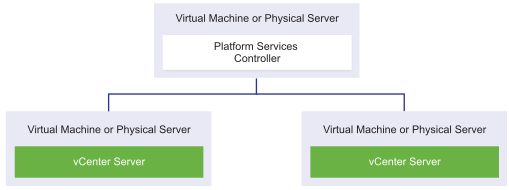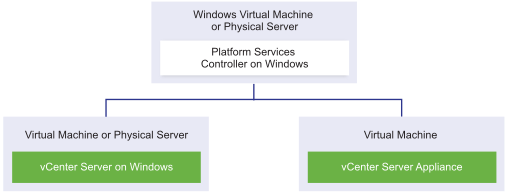You can deploy the vCenter Server Appliance or install vCenter Server for Windows with an embedded or external Platform Services Controller. You can also deploy a Platform Services Controller as an appliance or install it on Windows. If necessary, you can use a mixed operating systems environment.
| Deployment Type | Description |
|---|---|
| vCenter Server with an embedded Platform Services Controller | All services that are bundled with the Platform Services Controller are deployed together with the vCenter Server services on the same virtual machine or physical server. |
| Platform Services Controller | Only the services that are bundled with the Platform Services Controller are deployed on the virtual machine or physical server. |
| vCenter Server with an external Platform Services Controller (Requires external Platform Services Controller) |
Only the vCenter Server services are deployed on the virtual machine or physical server. You must register such a vCenter Server instance with a Platform Services Controller instance that you previously deployed or installed. |
vCenter Server with an Embedded Platform Services Controller
Using an embedded Platform Services Controller results in a standalone deployment that has its own vCenter Single Sign-On domain with a single site. Starting with vSphere 6.5 Update 2, other instances of vCenter Server with an embedded Platform Services Controller can be joined to enable enhanced linked mode.

Installing vCenter Server with an embedded Platform Services Controller has the following advantages:
- The connection between vCenter Server and the Platform Services Controller is not over the network, and vCenter Server is not prone to outages caused by connectivity and name resolution issues between vCenter Server and the Platform Services Controller.
- If you install vCenter Server on Windows virtual machines or physical servers, you need fewer Windows licenses.
- You manage fewer virtual machines or physical servers.
You can configure the vCenter Server Appliance with an embedded Platform Services Controller in vCenter High Availability configuration. For information, see vSphere Availability.
Platform Services Controller and vCenter Server with an External Platform Services Controller
When you deploy or install a Platform Services Controller instance, you can create a vCenter Single Sign-On domain or join an existing vCenter Single Sign-On domain. Joined Platform Services Controller instances replicate their infrastructure data, such as authentication and licensing information, and can span multiple vCenter Single Sign-On sites. For information, see Understanding vSphere Domains, Domain Names, and Sites.
You can register multiple vCenter Server instances with one common external Platform Services Controller instance. The vCenter Server instances assume the vCenter Single Sign-On site of the Platform Services Controller instance with which they are registered. All vCenter Server instances that are registered with one common or different joined Platform Services Controller instances are connected in Enhanced Linked Mode.

Installing vCenter Server with an external Platform Services Controller has the following disadvantages:
- The connection between vCenter Server and Platform Services Controller might have connectivity and name resolution issues.
- If you install vCenter Server on Windows virtual machines or physical servers, you need more Microsoft Windows licenses.
- You must manage more virtual machines or physical servers.
For information about the Platform Services Controller and vCenter Server maximums, see the Configuration Maximums documentation.
For information about configuring the vCenter Server Appliance with an external Platform Services Controller in vCenter High Availability configuration, see vSphere Availability.
Mixed Operating Systems Environment
A vCenter Server instance installed on Windows can be registered with either a Platform Services Controller installed on Windows or a Platform Services Controller appliance. A vCenter Server Appliance can be registered with either a Platform Services Controller installed on Windows or a Platform Services Controller appliance. Both vCenter Server and the vCenter Server Appliance can be registered with the same Platform Services Controller.

